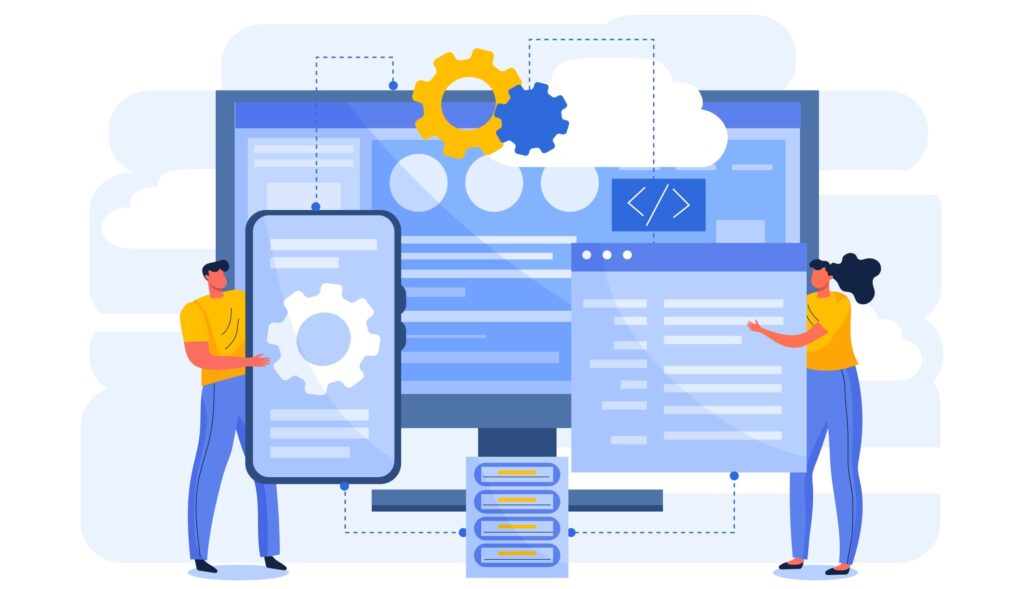Want to know what’s, and why’s of software customization? Then give this blog a read to get the utmost clarity on the topic!
In the technology-driven world, businesses are under constant pressure to stay ahead of the competition, adapt to shifting market dynamics, and improve operational efficiency. One of the most effective ways to achieve these goals is by adopting software that can be tailored to the business’s unique needs. While often effective for general tasks, ready-made software solutions fall short when it comes to meeting the specific requirements of a company. This is where software customization comes into play.
In this article, we will explore the concept of software customization, why it’s vital for businesses, and how it can help you stay ahead of the curve in a competitive environment.
Understanding Software Customization?
Software customization refers to the process of modifying a standard software package to fit the specific needs of a business or individual. While off-the-shelf software is designed to meet the needs of a broad audience, customized software allows businesses to tailor their tools and systems to their particular workflows, requirements, and goals. The customization can range from minor tweaks to major overhauls that affect the software’s functionality, user interface, or integration with other systems.
Why Businesses Choose Custom Software
Businesses turn to software customization for a variety of reasons, but the primary driver is the desire to gain a competitive edge. As industries become more specialized and the global marketplace grows more complex, businesses need tools that can adapt to their unique challenges and opportunities. In general, software, no matter how well designed, often lacks the flexibility required to address the specific needs of a company.
Software customization enables businesses to create a solution that is perfectly suited to their operations, ultimately improving efficiency, productivity, security, and profitability. With the right customizations, businesses can not only streamline their internal processes but also deliver a better customer experience, which is crucial in today’s customer-centric world.
The Spectrum of Customization Options
Software customization typically falls into several distinct categories:
- Interface Customization: Modifying the user interface to match company branding and improve user experience
- Functionality Adaptation: Adding, removing, or modifying features to match specific business processes
- Integration Customization: Ensuring seamless communication between different software systems
- Workflow Customization: Adjusting process flows to match company-specific operational procedures
- Data Management Customization: Modifying how data is collected, stored, and analyzed
How Software Customization Works
The process of customizing software is a detailed and collaborative effort between businesses and software developers. The customization typically involves the following stages:
1. Requirement Gathering
This phase involves understanding the business’s unique needs and identifying the specific features and functionalities required. This often includes discussions with key stakeholders within the business, such as department heads or end-users, to ensure the software meets their needs.
2. Design and Development
Once the requirements are clear, the software development team begins designing and developing the customized solution. This may involve modifying existing code, adding new features, or integrating third-party tools and systems.
3. Testing and Quality Assurance
After development, the customized software undergoes rigorous testing to ensure that it functions as expected. This phase also includes checking for compatibility issues, bugs, and any security vulnerabilities.
4. Deployment and Training
Once testing is complete, the software is deployed across the organization. Staff members are trained to use the new system, and feedback is gathered to identify any areas for further improvement.
5. Ongoing Support and Updates
The final phase of software customization involves providing ongoing support, monitoring performance, and implementing updates as needed. Custom software must evolve along with the business, and regular updates help to maintain its efficiency and effectiveness.
Why Is Software Customization Important for Businesses?
As industries evolve and businesses face new challenges, the need for specialized software becomes more pronounced. The role of software in digital transformation is undeniable, and software customization is key to unlocking the potential of this transformation. Below are the key reasons why software customization is becoming increasingly important for businesses.
1. Unmatched Flexibility to Meet Unique Business Needs
One of the biggest advantages of software customization is the flexibility it offers. Generic software typically comes with predefined features and functions, many of which may be irrelevant or unnecessary for your business. By customizing the software, you can focus on the features that matter most to your organization.
For example, if your business is in a niche industry with specific regulatory compliance requirements, off-the-shelf software may not have the tools needed to manage those compliance standards. Through customization, you can integrate these features directly into your system, ensuring that it aligns with both industry standards and your company’s operational needs.
2. Adaptability in a Rapidly Changing Market
The pace of change in today’s business world is faster than ever. To remain competitive, companies must be agile and able to adapt quickly to new market conditions, technologies, and customer preferences. Customized software enables businesses to respond to these changes by offering greater adaptability.
For instance, when your business wants to introduce new product lines or services, customized software can be adjusted to include the necessary features such as inventory management, customer support modules, or financial tracking tailored to your new offerings. This type of adaptability helps businesses stay relevant and responsive in a dynamic environment.
3. Improved Efficiency and Productivity
Generic software solutions often come with a variety of features that may not be useful to your specific business. For instance, a large organization with multiple departments might find that off-the-shelf software is cluttered with unnecessary tools, making it harder to train employees and reducing overall productivity.
Customization allows businesses to streamline workflows and reduce complexity by eliminating irrelevant features and focusing on the ones that directly impact their operations. Whether it’s automating repetitive tasks, simplifying the user interface, or integrating with existing systems, custom software can improve efficiency and reduce manual errors.
4. Enhanced Customer Experience
The success of any business relies heavily on its ability to meet and exceed customer expectations. Customized software plays a crucial role in improving customer experience by delivering more personalized and seamless interactions.
For example, an e-commerce company can tailor its website, order processing, and customer service tools to offer a more intuitive and personalized shopping experience. Customization allows businesses to integrate customer preferences, track buying behavior, and offer tailored recommendations, making the customer journey smoother and more enjoyable.
5. Security and Control Over Data
Cybersecurity is a major concern for businesses in today’s digital world. Off-the-shelf software may not provide the level of security that your business needs, leaving sensitive data vulnerable to breaches and unauthorized access. Customized software solutions offer businesses greater control over their data protection protocols.
Through customization, businesses can implement specific security measures, such as restricting access to certain features, adding encryption layers, and integrating real-time monitoring systems. These measures can significantly reduce the risk of data breaches and ensure that your business complies with regulatory requirements related to data security.
6. Cost-Effectiveness in the Long Run
While the initial investment in customized software may be higher compared to off-the-shelf solutions, it can be more cost-effective over time. Off-the-shelf software often comes with recurring costs such as subscription fees, licensing, and updates. Additionally, businesses may face additional costs for training staff to use features that are not relevant to their operations.
Customized software, on the other hand, is designed to address your exact needs, meaning that you only pay for the features and functionalities you require. As a result, businesses can save money on unnecessary features and avoid paying for software that doesn’t provide value to their operations. Furthermore, customized software can drive greater efficiency and productivity, ultimately resulting in cost savings.
7. Competitive Advantage
In a highly competitive marketplace, companies must leverage every possible advantage to differentiate themselves from their competitors. Customized software enables businesses to create unique solutions that address their specific needs, giving them a distinct edge over companies that rely on off-the-shelf software.
For instance, by developing custom software that integrates multiple aspects of your business—from sales and marketing to logistics and customer support—you can create a more cohesive, efficient, and customer-centric business model. This not only enhances internal operations but also enables you to deliver superior customer service, which is key to gaining a competitive advantage.
Implementation Strategies for Successful Software Customization
Effective software customization requires more than just technical modifications—it demands a strategic approach that aligns with business objectives and seamlessly integrates into existing workflows. To ensure successful implementation, organizations should focus on several key areas:
Strategic Planning Fundamentals
Before beginning any customization project, businesses must conduct a thorough assessment of their current processes and pain points. This analysis helps identify specific areas where customization can add the most value. For example, a retail business might discover that real-time inventory management is their biggest challenge, leading them to prioritize customization of their stock control systems.
Scalability considerations are equally crucial during the planning phase. The customized solution should be capable of growing alongside the business, accommodating increased data volumes, new market expansions, or additional product lines without requiring significant redevelopment.
Integration and Technical Considerations
Successful customization projects ensure seamless integration with existing business systems. This integration enables smooth data flow between different applications, from CRM systems to accounting software, creating a unified operational environment. The goal is to eliminate data silos and streamline cross-departmental processes.
Implementation Approaches
Organizations typically choose from three main approaches to software customization:
- In-house Development: Suitable for companies with strong technical teams, offering complete control over the software development process but requiring significant internal resources.
- Vendor Partnerships: Ideal for businesses seeking to modify existing solutions, leveraging vendor expertise while maintaining professional support.
- Hybrid Approach: Combines off-the-shelf solutions with custom modules, offering a balance between standardization and specialization.
Managing Change and Adoption
The success of customized software heavily depends on user adoption. Organizations should implement comprehensive training programs and clear communication strategies to ensure employees understand the benefits and proper usage of the new system. A phased training approach, starting with key stakeholders and gradually expanding to all users, often proves most effective.
Ongoing Support and Maintenance
Software customization is an ongoing process that extends beyond initial implementation. Organizations must plan for regular updates, bug fixes, and feature additions to maintain system effectiveness. Whether through internal IT teams or external vendors, having reliable support infrastructure is crucial for addressing issues promptly and minimizing operational disruptions.
Risk Management
Successful implementation requires careful attention to potential challenges, including:
- Budget control and cost management
- Timeline adherence and scope definition
- Quality assurance and thorough testing
- User resistance and adoption challenges
- Long-term maintenance requirements
By addressing these aspects proactively and maintaining clear communication throughout the project, organizations can significantly improve their chances of successful software customization implementation. The key lies in viewing customization not as a one-time project but as an ongoing process of optimization and improvement aligned with business objectives.
Challenges and Considerations
While software customization offers numerous benefits, it’s important to be aware of the potential challenges. Customizing software can be time-consuming and expensive, especially for large organizations with complex needs. There can also be compatibility issues when integrating customized software with existing systems.
To mitigate these risks, businesses should carefully assess their requirements and work with an experienced development team that understands their needs and industry standards.
Conclusion
In an increasingly competitive business environment, software customization has become an essential strategy for organizations looking to improve efficiency, enhance security, and gain a competitive edge. By tailoring software to meet the specific needs of the business, companies can unlock significant benefits, from increased productivity to better customer experiences.
While the process of customization requires careful planning, investment, and collaboration with skilled developers, the long-term rewards make it a worthwhile endeavor. Customized software provides businesses with the tools they need to succeed in a rapidly evolving marketplace, and the flexibility to adapt to future challenges.
If you’re looking to streamline your business operations, improve security, and stay ahead of your competitors, investing in customized software could be the key to your success.






3 thoughts on “What Is Software Customization and Why Is It Important for Businesses?”
Can you be more specific about the content of your article? After reading it, I still have some doubts on software customization. Hope you can help me.
Thanks for sharing about software customization, which most blogs don’t speak much on. I read many of your blog posts, cool, your blog is very good.
Thank you for your sharing. I really enjoyed this post, but it would be great if you could include more real-world examples.